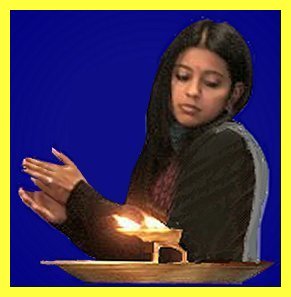
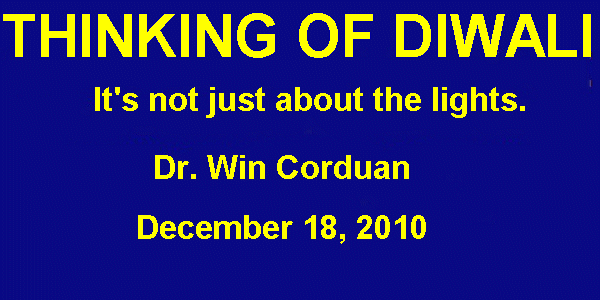
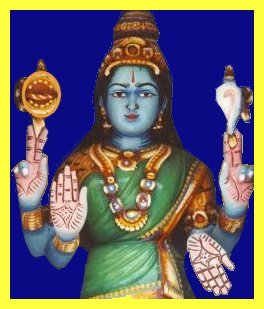
 |  |  |
These are a few blog entries on the Hindu festival of divali, which I posted just a few days ago. This format should make them much easier to read it since they are now in the correct order rather than bottom-to-top, as happens necessarily with blog entries. I also was able to take care of a few other matters, such as adding real footnotes and shuffling the pictures around just a bit--not to mention creating a couple of new ones. As is my custom in these compilations, I intentionally left the language and informality as that of a blog entry.
As I said the other day, I had been wanting to pursue the topic of historiography for a while, but other things keep coming to my mind. Now it's an obvious move to discuss the fact that the truth of biblical Christianity depends on the historical veracity of various events with regard to Jesus Christ, such as his existence, which presupposes his birth, which brings us to Christmas. That's always a good place to be, and from there we could move on to historiography, but once again, I'm being drawn along a tangent.
We celebrate Christmas with get-togethers, lights, and presents, among other things. So do quite a few other cultures and religions with their festivals. Any number of them have occasions to which they refer to as "Feast of Lights." It ocurred to me that a way of displaying the essential nature of Christmas would be by contrasting it with the Hindu festival of lights, usually known as Diwali. Then I remembered that I had a so-far-unpublished article on Diwali in my files, which is somewhat outdated by now.The original occasion for the article was the fact that in the fall of 2003 President George W. Bush brought idolatry to the White House by instituting the annual celebration of Diwali. This strategy to recruit the Indian immigrant vote actually backfired because he himself did not participate in the occasion. 1 Karl Rove represented the president on the first occasion because Mr. Bush was abroad. In later years other Republican dignitaries with some connection to India were in attendance and took leadership, even though the president himself was present in the White House, and the folks of Indian (viz. South-Asian) origin considered themselves offended. Personally, I was severely disappointed that the president, who was publicly known as an evangelical Christian, had brought an idolatrous ceremony into the White House. Maybe I have spent too much time in Chronicles, but your naive bloggist is not entirely above thinking that the lackluster later years of the Bush administration could be causally linked to such compromises.
Regardless, those considerations have become moot since President Obama has had no compunction about participating in this Hindu ceremony. 2 So, since Divali seems to have been integrated into our national culture, we should know what it is about, as well as maybe recognize some differences between the two "festivals of light."
This discussion will need at least two installments, and--who knows, maybe a few more if good questions come up, which let me extend it. I trust that the contrast with the simple and factual truth of the gospel will emerge naturally by contrast.


To put it simply, since observance of Diwali has become a routine function carried on in the White House, all Americans ought to know what this holiday is, and what it represents.
Very, very superficially, there is no question that Diwali is tantamount to the "Indian Christmas." It is oftentimes referred to as the "Festival of Lights," and it is by far the most popular of all Indian holidays. People decorate their houses with lights, and the celebration itself involves the lighting of lamps and candles, as I will explain next time. The practices of giving gifts and exchanging Diwali cards are as much of an integral part of the Indian business cycle as the Christmas boom is in Western countries. I am deliberately using the word "Indian" here because, even though we recognize Diwali most likely as a Hindu holiday, other major Indian religions, such as Sikhism and Jainism, have picked it up as well, though with different background mythologies and practices. And, just as has happened with Christmas in Western society, being a fairly secularized person will not stand in the way of one's observing this holiday. Even if you do not actually believe in the gods and goddesses, and even if you do not believe that the Diwali celebration entails commitment to religious belief, it is still enjoyable to get together with family and friends, to light the lamps and candles, and to give and receive presents.
One of my fundamental rules in understanding religious practices, including many within Christendom, is that for most rituals, in which I include virtually all activities ranging from simple prayers to large festivals, the chances are good that the performance of the ritual precedes its current explanations. Thus, for example, most Christians practice some form of water baptism, even though the interpretations of it may range all the way from
Similarly, some Christians think of communion as
And, to return to the analogy of a moment ago, Westerners are very likely to celebrate Christmas, whether it is as a time of remembrance of the birth of Jesus, or whether they think of it as a time for friends and family to get together. As long as there are colorful lights and presents, a specific religious meaning frequently takes a backseat.

In fact, let us stick with the example of Christmas for one moment longer. We all know that it is a part of the church calendar, and that, at least for true Christians, it is a time to remember the incarnation. But those facts do not actually tell us much phenomenologically about the origin of the celebration. Why did Christians begin to celebrate it exactly coterminous with the time of the Germanic Yule, which roughly coincides with the Roman Saturnalia? How did we arrive at the various customs (which, by the way, also vary from culture to culture) that many of us find indispensable for Christmas? In other words, knowing the story (the "myth" if you wish to emphasize the general pattern) behind the festival, does not necessarily give us the meaning for the practices of the festival as they are observed by its participants today or in the past.
One can, of course, approach them with a lexicon of universal meanings as expressed by hierophanies (Eliade) or archetypes (Jung), and I can't say that doing so is necessarily wrong from a scholar's point of view. (I'll be honest: I appreciate certain aspects of their work.) However, it only postpones the vital questions by one step. One wishes to know why the people recognized this particular hierophany in a specific event or object, or why a ceremony appears to embed that particular archetype rather than another.
Diwali is a highly representative example of these features. Virtually everyone in India (except for the Christians that I know) celebrates it. Muslims do not actually participate in the rituals, but observe the days as vacation days. However, most aspects of the celebration other than the lighting of rows of candles or oil lamps are variable. It is not so much a matter of how you do it or why you do it, just so long as you do it. I need to reiterate, though, that I do not consider this to be an unusual case among the world's religions, but one that applies to many religious rituals or activities.3
Thus, in describing Diwali in a form that is both fair and intelligible to us non-Indians, I need to begin by pointing out the diversity in the mythology concerning its origin and--extremely cursorily--some of the practices associated with it. Then, second, when I become a little more specific, I cannot help but limit myself intentionally to a form of Diwali that stands for a majority of its observances, viz. the elements that most people would think of when the topic of Diwali comes up. There are a number of stories in Hindu mythology that are given as the background for the origin of Diwali.4
| Just so that we do not get completely confused, I will mention at this point that, despite the many stories of origination, for most Hindus the fundamental story is the return of Rama and Sita to Ayodhya, and the central meaning has to do with invoking the blessing of the goddess Lakshmi, who is incarnated by Sita. |
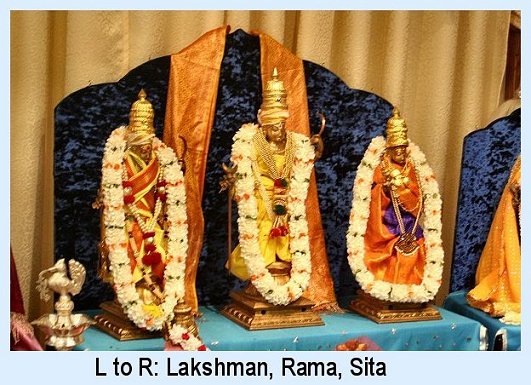
1. Sita: Avatar of Lakshmi as Sridevi. Rama was one of the incarnations (avatars5 ) of the god Vishnu, and his wife Sita was an incarnation of one aspect of Lakshmi, called Sridevi. In contrast to most male or female avatars, Sita (avatar of Sridevi) emerged out of a furrow of the earth, so that, insofar as she had a mother, it was the Earthmother, a second aspect of Lakshmi called Bhudevi. The epic Ramayana tells the story of how the demon king Ravana abducted Sita to Sri Lanka, and how, with the help of his brother Lakshman and the monkey Hanuman, after fourteen years, Rama was able to win her back.Their return to Ayodhya began a long era of peace, prosperity, and observance of the dharma. Thus, this narrative gives the background to Diwali in the defeat of Ravana and the return to Ayodhya of Rama and Sita, with emphasis on Sita's virtue.
2. Sathyabama: Avatar of Lakshmi as Bhudevi Another story provided as the origin of Diwali seems to be far removed from the previous one from the Ramayana, unless one is willing to thread through the paradoxical connections between deities and their avatars. This story centers on Krishna, another one of Vishnu's avatars, as well as an avatar of the second aspect of Lakshmi, named Bhudevi, who came to earth under the name of Sathyabama. Krishna had a number of wives, among whom, by the way, was another incarnation of the first aspect Lakshmi (Sridevi), going by the name of Rukmini this time, and there are some stories involving her, as well. There is no question, though, that Krishna's greatest love was Radha, who was neither an avatar nor a wife of his, but one of the Gopis, the milkmaids with whom he carried on frequently and intensely. 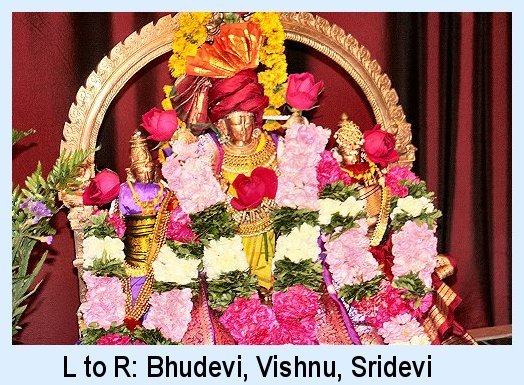
However, this story centers on Sathyabhama, who was an incarnation of the second aspect of Vishnu's wife, Lakshmi under the name of Bhudevi. As such, she is an Earth Goddess, and she is frequently pictured in a triad with Vishnu, standing on his right while Sridevi stands on Vishnu's left. In this context, Vishnu is frequently referred to as Venkateshvara, the Lord of this Age.
As is typical for the stories of the avatars of Vishnu, the object of this narrative was to kill an evil demon, who went by the name of Narakasura, a name that probably meant evil spirit ("asura") in human form ("Narak"). Now, Narakasura happened to be Bhudevi's own son. He had received a large amount of power from the god Brahma and, despite his glorious and pious heritage, was using this power to bring about a lot of evil. Krishna set out to defeat Narakasura, with Sathyabhama (Bhudevi's avatar) serving as his charioteer. When Krishna was hit by an arrow, Sathyabhama did not hesitate to return fire and kill her own son with her arrow. Afterwards, she declared that this day should be commemorated with a celebration, as a part of which Krishna took a bath of oil, which has become a regular practice for Diwali in some regions. Despite the clear differences between these first two stories, there is a strong common element in the focus on Lakshmi's avatar, this time as Bhudevi in the form of Sathyabhama, and her quest to eradicate evil.6
3. Lakshmi as the creator of the nectar of immortality. Another story adduced for the origin of Diwali involves Lakshmi's first appearance in the universe, this time as her own self, not as an avatar. Here she is, however, associated with the second avatar of Vishnu's, namely Kurma, the turtle. Kurma dove into the ocean in order to balance a mountain on his back, which the other gods could then use to churn the ocean in order to produce the nectar of immortality. The inventor of this wonderful potion was none other than Lakshmi, who became Vishnu's wife from that point on.
4. Bali, the generous demon king. Another event involving yet another avatar of Vishnu's is included in some places in the celebration of Diwali, though it does not involve a goddess. At one time, the demon king Bali had taken over the entire universe. In response to this threat to the dharma, Vishnu became the avatar Vamana, the disabled dwarf. He begged of Bali, just as a favor, if he might own as much territory as he could cover with three steps. Bali looked at the little, misshapen person, and, thinking there was not much to lose, generously agreed. However, since Vamana was actually Vishnu, the god, with his first two steps he covered the entire top and middle sections of the universe; different versions do not agree on whether he ever even took the third step, which would have given him the underworld as well. Now, even though in the original story, Bali's ambitions are presented as a dreadful scenario, people also recognize Bali's generosity---After all, he did not have to grant Vamana his three steps. Thus Diwali, which prizes generosity in the exchange of presents, acknowledges Bali's munificence for a day.7
5. There is also supposedly an aspect of a harvest festival to Diwali. This association is apparently due to two factors:
a) the timing at the end of October or the beginning of November.
b) the proclivity of some anthropologists to find the vestiges of a harvest festival in virtually all festivals of practically all religions. By and large these scholars are fertility-celebration-obsessed, and frequently their long-range motivation is to find an original goddess cult in the festival and, thus, at the root of the culture.8 Given what we actually know of the geographic and climactic diversity of India, this idea strikes me as unproductive. In principle, an explanation that explains everything explains nothing. Similar interpretations can be given to numerous and highly differing festivals, for example, the festival of Pongal, observed particularly in South India during January, and it does not provide any help with understanding whatever is distinctive about Diwali.
Next time we get into the center of the matter: what actually happens during Diwali. (You might even want to keep in mind the way I just phrased that statement .)

Maybe I pitched the balls just a little too fast across the plate in the last entry. Or, to relate to another segment of my readership, maybe my bowling carried a little too much spin. So, since I'm working on a solid headache at the moment, I won't add anything substantial, but I made two little charts that may perhaps clarify the stream of names of the relevant Hindu deities, their manifestations, their avatars, and their paradoxical relationships. Please keep in mind that the next four Hindus you may meet may each have a different scheme.
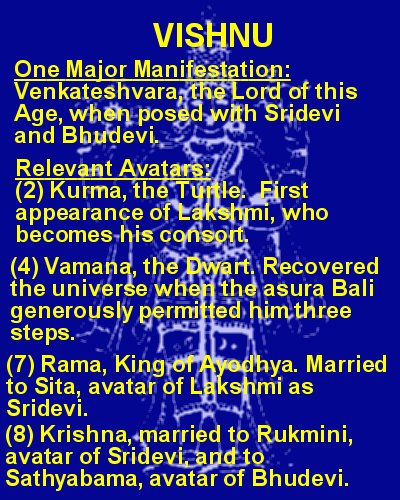 | 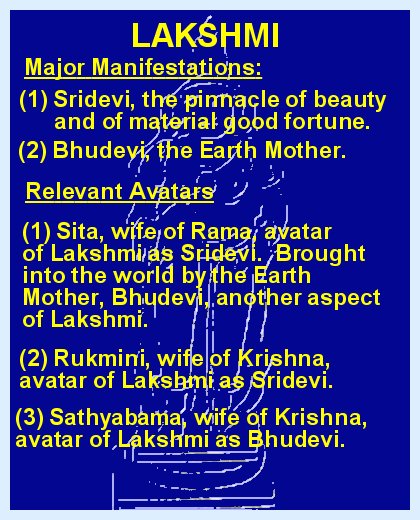 |
As I said, this is just an interlude. Back to more technicalities of Diwali next time.


Even though I started with a totally prepared paper, turning it into a blog entry with pictures, charts, unfounded opinions, and failed attempts at humor, has turned into a much more laborious task than I thought. Still, I think this is a topic on which some open words need to be said, whether they are required right now at this moment or later. Once again, I need to thank President Bush for making Diwali a permanent part of national celebrations in the White House, and President Obama for participating in it. These are actions that immediately become their own precedents. Humanly speaking, you can't celebrate Diwali in the White House one year and drop it the next. The people would dislike you and defintiely not vote for you. Maybe focusing on this topic will help us to sympathize a little more with the kings of the Old Testament, who just couldn't bring themselves to totally obliterate idolatry, and perhaps even bring us to a greater admiration for the kings who were willing to stand up against the idolatrous religions practiced requently by a majority of their subjects.

To return to the topic, Diwali provides us with yet one more example that apparent similarities in religions--both Hinduism and Christianity (among others) have festivals with lights, presents, and good feelings--are purely superficial. If you're not a believer in any one religion, that should not be all that important to you. I find it interesting that it is precisely skeptics on all religions who frequently believe they have discovered commonalities among various religions, when a closer look reveals that they are nothing of the kind. Could it be that they are looking for a ground for their skepticism by contriving non-existent parallels? But if you are a believer in one of the religions, it should be important to you whether two superficially similar celebrations really are the same. Specifically, if you are a believer in Jesus Christ, you should see that there is a vast difference between Diwali and its set of exorcistic rituals, cluttered with a collection of inconsistent myths, and the commemoration of God entering human history to suffer on our behalf.
India is not one culture, but many cultures, sometimes blended together fairly cohesively, sometimes only very superficially. It would be impossible to list here all of the variations of practices and their interpretations associated with Diwali. Thus, this quick summary will definitely be overgeneralized, and it is quite possible that the specific way in which I am describing it, is never actually practiced in any one location of
.
As mentioned already, Diwali is frequently called the festival of lights. Its original name, as used in the Sanskrit Scriptures is Dipavali, which literally means a “row of lights.
![]() (dipa or deepa) refers to the “lights” and
(dipa or deepa) refers to the “lights” and ![]() (vali or valee) means “row.” Thus, dipavali
(vali or valee) means “row.” Thus, dipavali ![]() is first and foremost simply the holiday on which we make a row of lights. Thus the name reveals the practice associated with the observance, not its meaning--the point that I keep insisting is so fundamental for us in coming to any religious practice from the outside. The present label "Diwali" is an abridgment brought about by the simplifications accompanying Sanskrit migration to Hindi. Interestingly, in some regions outside of India, such as Singapore, the holiday is known by its formal name, "Dipavali."
is first and foremost simply the holiday on which we make a row of lights. Thus the name reveals the practice associated with the observance, not its meaning--the point that I keep insisting is so fundamental for us in coming to any religious practice from the outside. The present label "Diwali" is an abridgment brought about by the simplifications accompanying Sanskrit migration to Hindi. Interestingly, in some regions outside of India, such as Singapore, the holiday is known by its formal name, "Dipavali."
Just in case it is still not obvious, the celebration focuses on the lighting of candles or lamps (oil lamps made of clay). Towards the evening, the family or other groups assemble to chant a phrase out of the Upanishads. 9
'Lead me from the unreal to the real! Lead me from darkness to light! Lead me from death to immortality!' 1:3:27

ASATO SAD GAMAYA, TAMASOMA JYOTIR GAMAYA, MIRTYORMA AMRITAM GAMAYA
From the unreal to the real lead me; from darkness to light lead me, from death to immortality lead me.
Virtually all commentators emphasize the three particular concepts here, go on to expound on the attributes of truth and knowledge, and then find some connection between those two virtues and immortality. They do so despite the fact that the Upanishad itself proscribes seeing anything here other than an attempt to elude death. To quote from the latter part of the very same verse:
| Now when he says, 'Lead me from the unreal to the real,' the unreal is verily death, the real [is] immortality. He therefore says, 'Lead me from death to immortality, make me immortal.' When he says, 'Lead me from darkness to light,' darkness is verily death, light immortality. He therefore says, 'Lead me from death to immortality, make me immortal.' When he says, 'Lead me from death to immortality,' there is nothing there, as it were, hidden (obscure, requiring explanation). |

Therefore, in the context, death and unreality are meant to be synonymous, and so "to come to the real" means "to escape death"; in the same way, darkness is synonymous with death, and so "to come out of darkness" is "to escape death"; and, finally, obviously, "coming to immortality" is "to escape death." The Upanishad itself explains the entire verse as a plea for immortality pure and simple. In short, "Please don't let me die!" In the previous context, death had been both the subject of discussion and the agent in the narrative, and, thus it makes sense that now the single point of the passage is to escape death. However, in the light of subsequent Vedantic interpretations in which knowledge (jñana) becomes the key to moksha, and presumably in the attempt to make a somewhat morbid passage appear a little more attractive, modern interpreters find in this verse more refined distinctions than its original context gives us. Regardless of this exegesis, though, I would not be surprised at all, if this verse had become included in the Diwali celebration originally, not because of its philosophy or religious meaning (which is there), butfirst and foremost because it alludes to light.(Compare the way in which many Christian congregations like to sing “Break thou the Bread of Life” right before partaking of bread during communion, when, in fact, the hymn is precisely not about bread made of dough nor its use in communion, but about studying the Word of God.)
Another part of this worship (puja) ceremony is the chanting of the Aarthi. This is frequently the closing ceremony of a temple service, in which lights are waved in front of the deities. At a normal puja, the priest carries out this duty, but frequently a group of worshipers may take turns holding and waving the lights, and this is the practice for Diwali.
Now, in most formats of Diwali it is Lakshmi around whom everything revolves.
 The generic word for "goddess" in Sanskrit is "devi." In relation to the male god, with whom a particular goddess is associated, she is called his shakti. "Shakti" means “power” in Sanskrit as well as in contemporary Hindi. For someone like me who had always associated the term “Shakti” with the goddess, it came as quite a surprise one day to see a box of breakfast cereal claim that its content was fortified with “iron-shakti.” The goddess is, in fact, the “shakti,” the “power,” both in her own right and insofar as she energizes the male god with whom she is associated. The clearest example of this synergism is, of course, Shiva and Parvati, who are frequently displayed as lingam-yoni, the conjunction of the male and female organs. The basic idea is that the goddess brings about sexual arousal in the god and thereby allows him to liberate his powers. This is true in theory for all Hindu gods and goddesses, and thus we have the couples of Brahma and Sarasvati, Vishnu and Lakshmi, and so on. However, the fact that this description applies almost universally does not mean that it always has cultic significance. In the case of Lakshmi, her role in activating Vishnu tends to vary from school to school and from region to region. Diwali, however, brings her to the forefront.
The generic word for "goddess" in Sanskrit is "devi." In relation to the male god, with whom a particular goddess is associated, she is called his shakti. "Shakti" means “power” in Sanskrit as well as in contemporary Hindi. For someone like me who had always associated the term “Shakti” with the goddess, it came as quite a surprise one day to see a box of breakfast cereal claim that its content was fortified with “iron-shakti.” The goddess is, in fact, the “shakti,” the “power,” both in her own right and insofar as she energizes the male god with whom she is associated. The clearest example of this synergism is, of course, Shiva and Parvati, who are frequently displayed as lingam-yoni, the conjunction of the male and female organs. The basic idea is that the goddess brings about sexual arousal in the god and thereby allows him to liberate his powers. This is true in theory for all Hindu gods and goddesses, and thus we have the couples of Brahma and Sarasvati, Vishnu and Lakshmi, and so on. However, the fact that this description applies almost universally does not mean that it always has cultic significance. In the case of Lakshmi, her role in activating Vishnu tends to vary from school to school and from region to region. Diwali, however, brings her to the forefront. 
![]() Durga, who is frequently shown destroying a buffalo-headed demon,
Durga, who is frequently shown destroying a buffalo-headed demon,
![]() Kali, who epitomizes this phase, and
Kali, who epitomizes this phase, and
![]() Periachi, who in
Periachi, who in
 The other two are not as easily recognized by someone only casually acquainted with Hinduism.
The other two are not as easily recognized by someone only casually acquainted with Hinduism.

Thus, this is the central point toward which I have been laboring all along now. Diwali is not an observance or commemoration, as is typical for religious festivals, but it is an elaborate ceremony or ritual, intended to influence the spiritual world in its own right. Other holidays in other religions (including Hinduism) may be commemorations that have rituals connected to them; Diwali is a ritual loosely connected to one or more commemorations. When you celebrate Diwali, you are actually carrying out a function alongside the goddess in fighting against the evil spirits.
Diwali is very different from other holidays to which we might be accustomed. Christmas is a festive time, when we remember the birth of
So, there you have the difference between Christmas and this other "festival of lights." It is a fundamental difference: the distinction between a) rejoicing in what God has done in history and b) participating in the present activities of a mythological goddess. We can spend a lot of time debating whether deities, such as Lakshmi, are actual spiritual beings (i.e. fallen angels) or fictional substitutes for spiritual realities (I tend to believe the latter). In either case, though, by participating in the festival, one is, at least provisionally, acknowledging Lakshmi and her power. Diwali is a night of the battle for the universe; it is anything but "Silent Night, Holy Night."
 NOTES
NOTES 
1 See "Lighting the Way" (unsigned article) in India Today (International) 2,45 (November 10, 2003):25, followed a year later by The Times of India (online version), November 13, 2004. URL: http://www.freerepublic.com/focus/f-news/1279462/posts#comment. In the first year Bush was praised for the innovation; subsequently he was accused of "snubbing" the people. Back to text.
2 Would someone please save us from the people who keep saying President Obama is a Muslim, or-- for that matter--a committed adherent to any religion? Unfortunately he does not appear to manifest convictions concerning anything ultimate. Back to text.
3 I trust that you are not missing the significant nature of this point for religious scholarship. It has tremendous influence on the way in which we approach a study of religious practices, frequently refered to as the religion's cultus. When we observe a ritual, we tend to want to know what the ritual means. The chances are that a well-informed member of the religion will tell us what it means. However, in many cases chances are that another well-informed member will also tell us what it means, and his explanation may be different from the first one.The problem is that, at least from the vantage point of an outsider, there may be multiple valid meanings from equally creditable sources attached to the ritual, and there is a good chance that the ritual was practiced before any present meanings had yet been thought of. This assertion does not imply that no practice can have a knowable unique meaning that has been maintained since its inception (e.g. Passover comes to mind), but it would take some clear indications that we really have our fingers on the original interpretations. Two good examples out of Judaism illustrate the ambiguity: Look up why Jews sway back and forth during prayer, or why the groom crushes a glass under his foot at the end of a Jewish wedding ceremony. It's not that there is no explanation; there are too many explanations.The lesson for students of religious culture is one of caution: Don't necessarily think that when an adherent "explains" something to you, he is representing anything but his own opinion, or his tradition. It often takes a whole lot more research to identify a historical origin or the present state of consensus among believers. Back to text.
4There are many standard sources for the stories behind Hindu gods. Recently, the website http://www.karma2grace.org added an "Encyclopedia of Hindu Gods." Classic treatments include Danielou, Alain. The Myths and Gods of India. Rochester, Vermont: Inner Traditions International, 1991. Originally published in 1965 as Hindu Polytheism. Thomas, P. Epics, Myths and Legends of India. Bombay, India: D. B. Taraporevala Sons & Co. Private Ltd, 1961. Moor, Edward. The Hindu Pantheon. Los Angeles: Philosophical Research Society, 1976. This is a reprint of a volume stemming out of the early nineteenth century. Back to text.
5I might just point out that the word "avatar" has a specific meaning in Sanskrit, based on the prefix "ava," which means "down" or "downward."An avatar is a divine being who descends to earth. The present illiterate use of it in reference to cartoonish representations of persons was tolerable at first, and would have remained so if people were not now starting to insist that this was "the true" meaning of the term. Yes, of course you can use any word any way you want to, just as Humpty Dumpty maintained, but how are you going to make sense of living in the real external world if you choose to label things in it according to your own whim?---- Sorry. If you're reading this, I'm undoubtedly preaching to the choir, but in that case an "amen" would be in order.  Back to text.
Back to text.
6By the way, Western writers who complain about some of the graphic content of the Bible in order to glorify other mythologies, beyond the shadow of a doubt could never have read thoroughly the mythologies of other religions, or, if they did read them, forgot them all immediately or deliberately prettified them. Surely they wouldn't just ignore the challenging parts for polemical reasons? Or would they? (Purely subjectively, I would say that Aldous Huxley would have been king among them, but every time that I have settled on who could have been his grand vizier, yet another, better, name comes to mind. Any suggestions?). Back to text.
7 Were the "asuras" really evil spirits in Hindu mythology? We are accustomed to portray them as such, and for later Hinduism, as a whole, this is not unfair. The farther along you proceed in history, the more the asuras take on the role of evil spirits. However their original posture in early Indo-European (IE) religion appears to be neutral, on a par with the devas, so that, for example, their counterpart in Norse religion, the aesirs would became the main gods in that frigid part of the world. In early Vedic religion, the asuras were not on good terms with the devas, but not necessarily evil. Varuna, a sky god, for example, became absorbed among the devas, even though initially he clearly was an asura and was defeated by Indra in combat. Most asuras took on the character of evil spirits more and more as the mythologies developed. Knowing that at one time the asuras were not necessarily thoroughly evil, makes it seem less startling that one of their group should be honored during a festival, but it still strikes me as idiosycratic, particularly when we are thinking of one who suffered such a humiliating defeat at the hands (Woops! Sorry. . . . . at the gnarled feet) of Vishnu's avatar.
The discovery and study of an extensive IE culture has been able to provide some perspectives on features in specific cultures that appear to break that culture's own rules, by demonstrating that they come from farther back, namely the ancient IE lineage. By demonstrating parallels and clusters of development among some of the IE cultures, it has also ruled out the claims made by some extremely nationalistic Hindus that the culture of the Indian subcontinent is the mother of all worthwhile cultures.These latter claims are enjoying a certain amount of popularity these days among some nationalistically inclined folks, but they would have plausibility only on the assumption that all other IE cultures grew out of the Indo-Aryan (that is, the proto-Hindu) version. IE languages and what they reveal of pre-Indo-Aryan IE cultures clearly demonstrate that they were derived from a common ancestor, and are not the ancestor of all others. Thus, the degree of its probability is negligible; or, to say something in straight English for a change, it is impossible. But remember that the events of history (not to mention the reception of a few light psychological bruises by your sensitive and egalitarian bloggist) have shown that a false national pride can easily trump reason in the lived world. Back to text.
8If their success seems unlikely to you, you are apparently not aware of some of the rare and esoteric gifts with which they are endowed. Their eyes are able to discern fertility symbols, where few people see anything but lines and circles. Furthermore, if the calendar seems to forbid an association with a harvest, some of their masters are able to invoke--or at least to authoritatively imagine--a shift in the culture's calendar. Back to text.
9Brihadâranyaka Upanishad II, 1:3:27, in Sacred Books of the East, vol. 15, trans. Max Müller, 1884, now available at http://www.sacred-texts.com/hin/sbe15/sbe15054.htm Back to text.